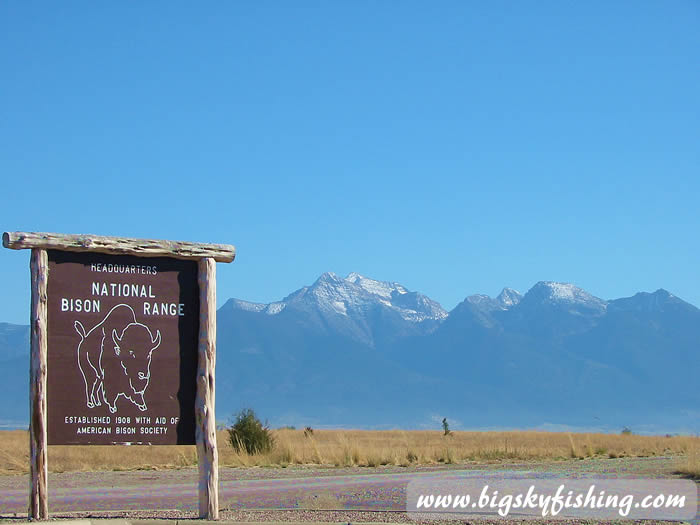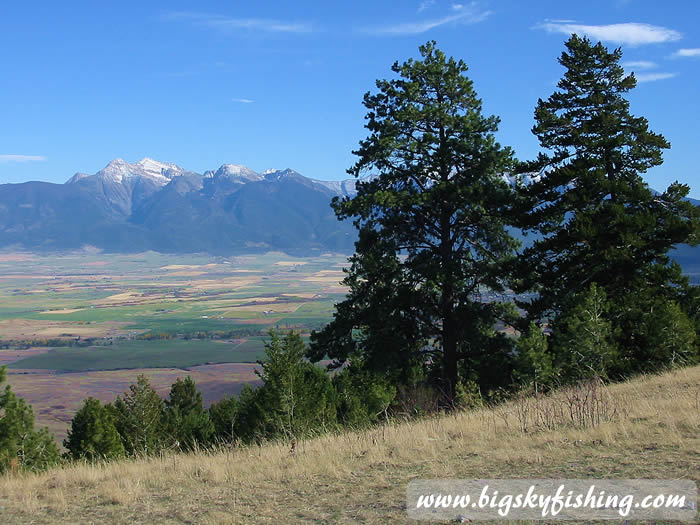The National Bison Range is one of the more unique wildlife refuges in the United States. Tucked away in the southern portion of the Flathead Valley in Northwest Montana, the National Bison Range is a wonderful place to see beautiful scenery, large herds of grazing buffalo, elk, antelope and other prairie wildlife.
 |
| Entrance to the National Bison Range |
The National Bison Range was established in 1908 and is one of the oldest wildlife refuges in the United States. It was created to serve as a refuge for the Bison, also known as a Buffalo. The refuge is relatively large, standing at 18,500 acres.
The Bison Range consists of a wide variety of habitats. The primary habitat in the range consists of rolling prairie. Large hills and small mountains form the heart of the range, with prairie being the dominant feature, even on the taller hills. But, in some areas of the refuge, pine forests are tucked away on more moist slopes. Additionally, along the lower boundaries of the range, several streams create areas of small wetlands.
There is little in the way of hiking in the National Bison Range. Instead, a decent condition one-way gravel road, Red Sleep Mountain Drive, makes it way up and over the small mountains on the middle of the range, and then traverses along its northern boundary. Only a handful of short nature trails (from near the top of the mountains) allow for off-road exploration. I suspect the reason for this is because of the herd of 300 bison. The refuge doesn’t want backcountry hikers stumbling into the herd.
The other reason, of course, is that Bison are wild animals, not enlarged horses. Unlike in Yellowstone National Park, where it seems someone each year gets trampled around by a Buffalo because the person got too close, the National Bison Range has avoided this problem by keeping all visitors in their cars. However, in the event you ignore their rules and end up face to face with a Buffalo, here's how to determine their mood.
A bison's tail is often a handy warning flag. When it hangs down and is switching naturally, the animal usually is unperturbed. If it extends out straight and droops at the end he/she is becoming mildly agitated. If the tail is sticking straight up, they are ready to charge and you should be somewhere else, just don’t run to get there.
 |
| Scenic Views Abound in the Bison Range |
A great little day-use and picnic area exists right near the wildlife headquarters. Additionally, the refuge headquarters is full of fascinating information and exhibits about the Bison and other wildlife in the refuge. Note, there is no camping allowed on the refuge and the refuge itself is closed at night.
Additionally, the road that goes up into the mountains (Red Sleep Mountain Drive) is closed from mid-October through mid-May (the lower portion of the road, called the Prairie Drive/West Loop, remains open all year. More information about the Red Sleep Mountain Drive.
Overall, the National Bison Range Wildlife Refuge is a great place to visit. Wildlife, especially Bison, are readily seen on most days. Other wildlife, particularly deer and antelope, are also common. On top of that, the beautiful scenery of the range itself makes a visit to the range a definite must for anyone venturing to this part of Montana.
Directions to the National Bison Range
The National Bison Range is located in the southern portion of the Flathead Valley and lies within the Flathead Indian Reservation. For anyone visiting Kalispell or Missoula, a side trip to the refuge is easy.
- From Missoula : Travel north on US Highway 93 to Ravalli, turn left(to the west) on to State Highway 200, travel approximately 5 miles to the junction of Highways 200 and 212, turn right(to the north) and travel approximately 5 miles to the entrance of the Range at Moiese.
- From Kalispell : Travel south on US Highway 93 or State Highway 35 to Polson, then travel Highway 93 through Pablo and Ronan to the junction of Highway 93 and State Highway 212, travel 12 miles (through Charlo) to the entrance of the Range at Moiese.
- From the West : Travel Highway 200 through Dixon to the junction of Highways 200 and 212, turn left(to the north) and travel approximately 5 miles to the entrance of the Range at Moiese.
- Nearest Major Towns : Polson
